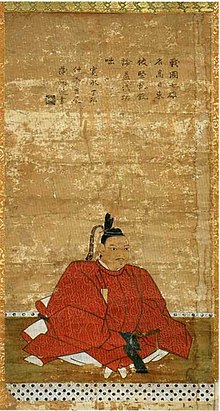| Wakisaka Yasuharu | |
|---|---|
| 脇坂 安治 | |
 Wakisaka Yasuharu Wakisaka Yasuharu | |
| Lord of Awaji Island | |
| In office 1585–1626 | |
| Succeeded by | Wakisaka Yasumoto |
| Personal details | |
| Born | 1554 Nagahama, Shiga, Japan |
| Died | September 26, 1626(1626-09-26) (aged 71–72) |
| Military service | |
| Allegiance | |
| Battles/wars | Tanba Campaign Siege of Miki Tenshō Iga War Battle of Shizugatake Kyūshū campaign Odawara campaign Korean campaign Battle of Sekigahara |
Wakisaka Yasuharu (脇坂 安治) (1554 – September 26, 1626), sometimes referred to as Wakizaka Yasuharu, was a daimyō (feudal lord) of Awaji Island who fought under a number of warlords over the course of Japan's Sengoku period.
Biography
Wakisaka originally served Azai Nagamasa but after Azai's downfall in 1573, he attended the Oda clan. As a yoriki of Akechi Mitsuhide a vassal of Oda Nobunaga. he distinguished himself during the assault on Kuroi Castle in 1578 at Tamba Province.
Later, he applied directly to Hashiba Hideyoshi to become his vassal. He later gained more success during Hideyoshi's Chugoku campaigns with assaults on Kanki Castle and Siege of Miki Castle in Harima Province.
In 1581, he took part on Tenshō Iga War, he was one of several general who led Nobunaga's troops in the Siege of Hijiyama.
The following year In 1582, Akechi betrayed Oda Nobunaga and took his power and lands, but was defeated two weeks later at the Battle of Yamazaki. Wakisaka then joined the victor, Hashiba Hideyoshi, who had become a conspicuous figure as a retainer of Oda Nobunaga.
Following the Battle of Shizugatake in 1583, Wakisaka came to be known as one of the shichi-hon-yari (七本槍), or Seven Spears of Shizugatake. These Seven would be among Hideyoshi's most trusted generals, especially in naval combat. Wakisaka was granted the fief of Awaji Island, worth 30,000 koku, in 1585.
He was then made commander of part of Hideyoshi's fleet, taking part in Hideyoshi's 1587 campaigns in Kyūshū, the 1590 Siege of Odawara, and the invasions of Korea, which took place from 1592 to 1598.
Korean campaign
In 1592, Wakisaka led 1,500 soldiers and landed on the Korean peninsula. He was defeated by Admiral Yi Sun-shin at the battle of Hansando and lost most of his fleet. Barely surviving the battle, he hid on a nearby uninhabited island and lived by eating seaweed until the enemy withdrew. He participated in both ground and naval actions in various places on the Korean peninsula. He was also ordered to dispatch a 1,200-man fleet during the Keichō Invasion and annihilated a Korean fleet attacking his position which was led by Won Gyun during a counterattack in July 1597. Despite his actions, he was unable to counter Admiral Yi Sun-shin, whose naval activities effectively cut off Japanese naval supply lines to the Korean Peninsula; despite this failure and the ultimate defeat of the Japanese forces during the campaigns, Wakisaka's reward for participating in this war was an increase in territory to 3,000 Koku.
Battle of Sekigahara
In 1600, Wakisaka was going to side with Tokugawa Ieyasu, but was compelled to oppose him, siding with Ishida Mitsunari, who had raised Wakisaka's army when he stayed in Osaka. On October 21, during the decisive Battle of Sekigahara, Wakisaka switched sides along with Kobayakawa Hideaki, he defeated Ōtani Yoshitsugu's force, and contributed to the Tokugawa victory.
After the battle, Tokugawa allowed Wakisaka to continue governing his domain of Awaji. In succeeding years, he was given another fief, at Ozu, Iyo Province, worth 53,000 koku. His son, Wakisaka Yasumoto, succeeded to the house after his death.
Popular culture
- Portrayed by Kim Myung-soo in the 2004-2005 KBS1 TV series Immortal Admiral Yi Sun-sin.
- Portrayed by Cho Jin-woong in the 2014 film The Admiral: Roaring Currents.
- Portrayed by Byun Yo-han in the 2022 film Hansan: Rising Dragon.
References
- Turnbull, Stephen (1998). The Samurai Sourcebook. London: Cassell & Co. p. 34,49,234. ISBN 9781854095237.
- 『天正記』第七巻所収「ちやうせん国御進発の人数つもり
- "The Admiral (2014)". IMDb. 30 July 2014. Retrieved 4 March 2017.
- Park Jae-hwan (June 22, 2022). "영화 '한산:용의 출현', 변요한 왜군 장수 와키자카 변신" [Movie 'Hansan: The Appearance of the Dragon', Byun Yo-han transforms into Wakizaka, a Japanese general] (in Korean). KBS Entertainment. Retrieved June 22, 2022 – via Naver.
Further reading
- Turnbull, Stephen (1998). The Samurai Sourcebook. London: Cassell & Co.